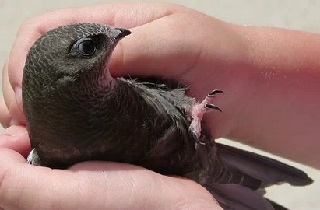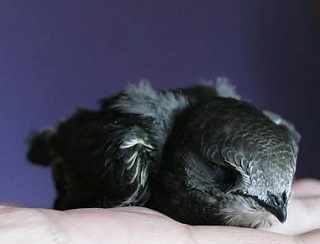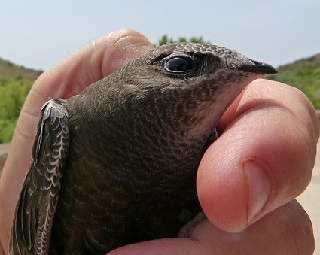 | > Other English exercises on the same topics: Animals | Making portraits, describing | Nature [Change theme] |
| > Similar tests: - Describing a face - Animals (video) - Animals - Describing a picture - In the sea - Animals & insects - Animals and pictures - Animals | |
| > Double-click on words you don't understand |
Black swift 1 - English lesson
We know at least three species of swifts which live in Europe but there are at least about 70 species of swifts through the world: the black swift or Apus apus, the smallest, which comes from the Southern countries of Africa and nests in Europe and in the Middle East, from April till the end of July (about 20th).
The pale swift which is brown and the Alpine swift with its white belly, are bigger than Apus apus. The pale swift stays in Europe until October and nests twice. The only one which stays in Europe or around the Mediterranean sea in winter is the Alpine swift. The others turn back to the Southern countries of Africa.
As this bird never lands, except when it nests, we have very little data about it, and we are still in the early stages of the knowledge for this topic: except when a bird falls on the ground, and goes to the Wild Life Centre, it is automatically ringed and a tiny camera GPS is fixed to its body to obtain data for ornitology; when it is cured, it can fly again. All over the world, enthusiasts live with their eyes turned to the sky.
In winter, Apus apus or black swift, and the pale swift, both live in equatorial and even in southern countries of Africa. These birds are usually starving, dehydrated, exhausted when they arrive in Europe in the middle of April to breed. They have a life expectancy of twenty years.
Black swifts never land, except for nesting, only once in a year.
When they are on the ground by accident, they have trouble taking off on their own, because they are too short-legged. On the ground swifts are always in danger! On the contrary, most of the other birds can survive if they are on the ground and go on being fed by their parents!

Their domain is the sky: they eat, sleep, clean their feathers, fight, breed while flying! On-board cameras have confirmed this. Swifts are really astonishing birds!
During the day, they can climb to 3,000 metres above the sea level, except when they have their brood to feed, then they perform an incessant ballet between the nest and their hunting place. The breeders, likely to be aged three years old and over, are the only ones to land. They live in our buildings holes, or artificial specific nest boxes for them. Black swifts are very clean because they carry their fecal bags out of the nest. You have to see how fast they arrive to land in this tiny hole of their nest, decelerating just before landing! In some artificial nests, scientists have put cameras to observe them.
In the evening, they rise very high in the sky and let themselves be carried by the updrafts. When they sleep, only one part of their brain rests while the other one watches, alternating.
Like all birds, they are faithful to their partner, and to their nesting place. If the building has been destroyed, the couple will not nest again : the journey and all the dangers they have gone through is energy lost for nothing.
They can be found all over Europe and the Middle East, from the Scandinavian countries to the Mediterranean sea, where enthusiasts of these birds study, help feed them and cure them when needed, notably in Frankfurt, Germany, where a veterinary clinic is specialised in swifts; there is another one at CEDAF near Maisons-Alfort, France; and if needed, we can phone to the Veterinary Clinic of the swifts, "The Hirondelle" in Saint-Forgeux, in France.
Let's observe them: the sickle-shaped aerodynamic silhouette of these black birds, true Formulas One of some forty grams as an adult, crisscross our European territories at sunrise or at sunset: acrobats flying in the middle of our buildings in frenzied sound rounds, with "Sssrrriii! Sssrrriii! Sssrrriii!" strident, which are their territorial phonetic marks, while they feed exclusively on insects suspended in the aerial plankton. They eat lots of mosquitoes, flies, and so on. When flying, they spit hunted insects that are not convenient to them out!
Be careful, birds do not understand glass facades (or windows) because they reflect the landscapes they have just crossed by: just paste a drawing, to prevent them from getting hurt or kill themselves. We can all do it to help the birds! Swifts also nest between windows (or/and doors) and their roller blinds, in fact in every high places they can find. In these dangerous places, they can be squashed.

If you find swifts on the ground, call these centres. But we'll see all of that in another chapter.

Answer the ten questions. All the answers are given in the lesson.
Now, it's up to you!
Have fun and good luck!
English exercise "Black swift 1" created by chocolatcitron with The test builder. [More lessons & exercises from chocolatcitron]
Click here to see the current stats of this English test
End of the free exercise to learn English: Black swift 1
A free English exercise to learn English.
Other English exercises on the same topics : Animals | Making portraits, describing | Nature | All our lessons and exercises


